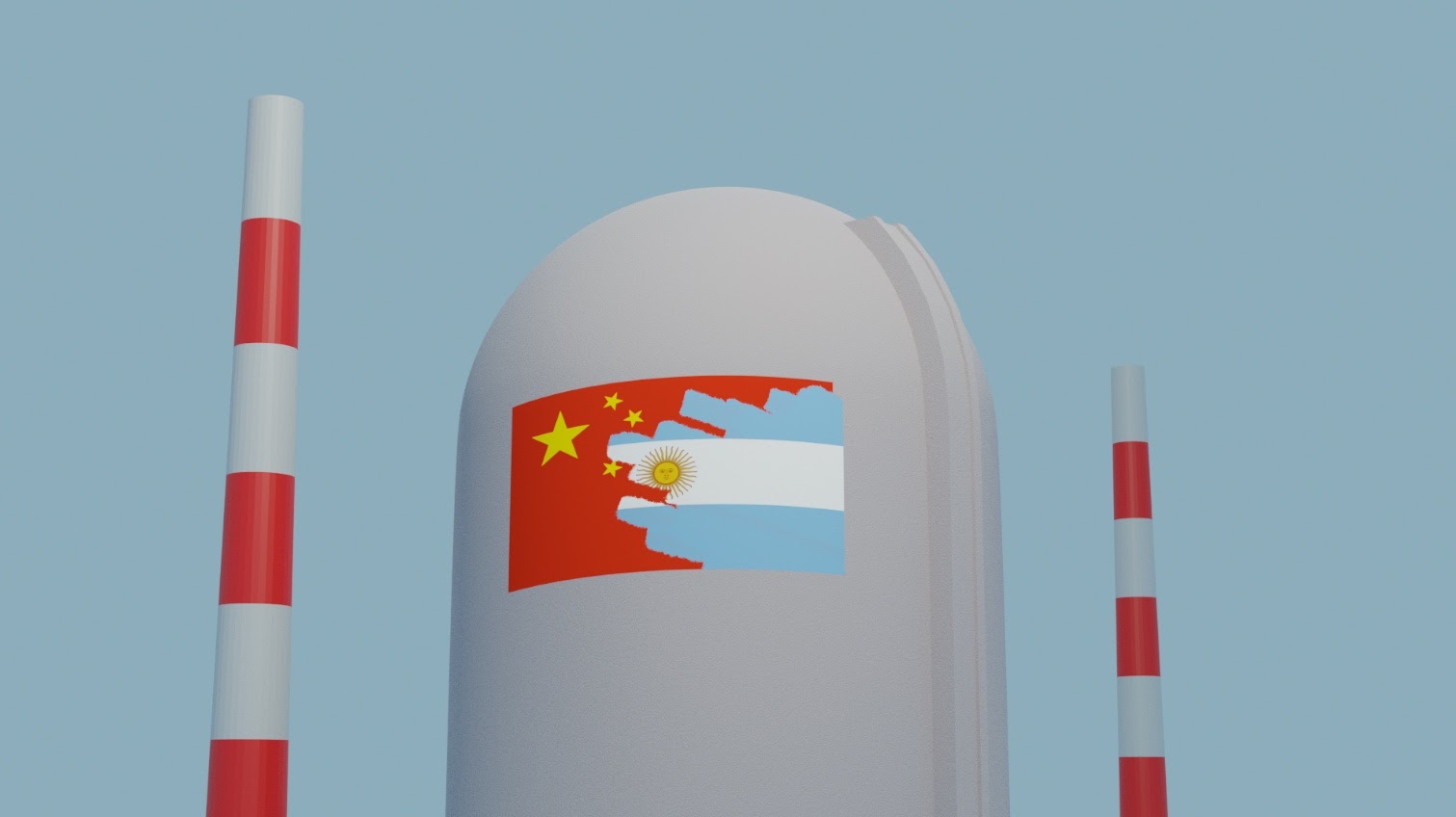Chinese nuclear energy in Argentina is in trouble
Half a decade has passed since China and Argentina signed the first of several agreements promising the first Chinese-built nuclear plant in a Latin American country. What could have been a milestone for the global ambitions of the growing Chinese nuclear industry is now stalled and without a clear restarting date.

Last February, an Argentine newspaper headlined a story “Concerns over a Chinese nuclear experiment at the very heart of Latin America,” hinting at an apocalyptic nightmare nascent in the region. Evoking the Fukushima and Chernobyl nuclear disasters, the article connected Chinese plans for a nuclear power plant to another controversial project in Argentina: the Deep Space Exploration Station.
Located in the southern province of Neuquén, the installation was meant to provide support to China’s space program (including its recent mission to Mars), but has been questioned for its ties to the Chinese People’s Liberation Army, which commands the country’s space program. Amid accusations of weak local oversight of the station’s operations, concerns — and conspiracy theories — about its true purpose have circulated in Argentina, and beyond to Washington, D.C.
Friction over nuclear power and the Deep Space Exploration Station come after several years of explosive growth of Chinese investments in and trade with Argentina. In April 2020, China officially displaced Brazil as Argentina’s largest trading partner, mainly due to huge imports of Argentinian soybeans, beef, shrimp, and vegetable oils. With its Argentinian-based operations, China Oil and Foodstuffs Corporation (COFCO) was the second-biggest exporter of Argentina’s grain and oilseeds in the first half of 2020, mainly as livestock feed. There are currently negotiations for Chinese investment in local pork-processing plants and farms. Chinese entities would invest around $4 billion, which could double Argentina’s pork production in the next four years.
China: Argentina’s banker of last resort?
In contrast to agricultural products, nuclear technology obviously attracts more scrutiny in the region. Last year, the U.S. Department of State was adamant in its goal to discourage allies from cooperating with China’s nuclear projects. Christopher Ford, the assistant secretary for the Bureau of International Security and Nonproliferation, said that Russia and China “use reactor sales by their heavily state-supported nuclear industries as a geopolitical tool to deepen political relationships with partner countries, to foster energy dependence by foreign partners, and sometimes even to use predatory financing to lure foreign political leaderships into debt traps that give Beijing or Moscow leverage that it can exploit later for geopolitical advantage.”
Back in the private sector, many non-Chinese multinationals operating in Argentina are not happy, either. According to Bloomberg, after 15 years operating in the country, Latam Airlines is ceasing its domestic flights in Argentina; Delta and American Airlines are ending some routes to the country; Honda stopped building cars there; and firms like BASF plan to shift their production to Brazil. Attracting more foreign direct investment to Argentina is increasingly challenging.
Despite U.S. advice, China has become an essential source of investment funds that Buenos Aires is unable to get from the U.S. and other developed economies, mainly due to the consequences of its traumatic default on foreign debt in 2001 and subsequent disagreements with bondholders and vulture funds. Chinese resources have poured into needed sectors in the Latin American country: New infrastructure projects include two major hydroelectric dams and the refurbishment of railway lines.
One nuclear plant, two plants…now none?
The many steps and negotiations involving the nuclear deal between China and Argentina kicked off in 2014, when both governments signed a cooperation agreement for the construction of a single nuclear power plant, which would join the three reactors Argentina already had in place (known as Atucha I, Atucha II, and Embalse). Later, that agreement was modified to include China’s third-generation nuclear reactor Hualong-1, to be constructed by China National Nuclear Corporation (CNNC), one of China’s two nuclear national champions. The modification was mostly due to Beijing’s interest in promoting the sale of its own nuclear technology, offering at the same time to fund an additional nuclear plant based on Argentinian technology, benefiting its economy and local nuclear industrial sector.
For these, Beijing committed 85% of a total investment of $15 billion. A key for this deal was that, compared with Pakistan, where CNNC is currently building two Hualong-1 reactors, Argentina possesses a longer tradition in nuclear research, thanks to the construction of Latin America’s first research reactor (1957) and first nuclear power plant (started in 1968, finished in 1974). So projects approved by Buenos Aires would serve as a more attractive representative for Chinese tech than Pakistan to tempt other potential buyers around the world.
But just days after both countries celebrated this important step in their path to nuclear cooperation, Argentina held its 2015 presidential election, removing from power the China-friendly president Cristina Fernández de Kirchner.
The newly elected president for the 2015–2019 period was Mauricio Macri, a businessman and staunch supporter of Washington and its market-oriented policies. Macri promptly stated that his government would review the previous agreements with China signed by his predecessor. Ironically, the new administration was soon overwhelmed by an economic crisis that needed a $56 billion rescue package from the International Monetary Fund (IMF). The empty pockets of the Argentinian treasury pushed Macri’s government to be on good terms with both Beijing and Washington.
Construction of both nuclear plants was due to begin in 2016, but the new Argentinian Secretary of Energy confirmed that there would be no new developments, given that contracts with China were under further scrutiny. As a result of the review, Buenos Aires proposed to pause the Hualong-1 reactor and to move forward with a CANDU plant, a type of Canadian pressurized heavy-water reactor that Argentina first acquired in the 1960s. That reactor garnered support among Argentina’s industry and scientific communities, primarily because they already had the expertise and the technology. Finally, in 2018, Macri decided to cancel the construction of both Chinese nuclear plants due to budgetary constraints.
This decision threw cold water on China’s plans, and it was seen as the result of internal criticism in Argentina over the need for more nuclear energy and its environmental risks. The initial location for one of the plants financed by China was in the southern province of Rio Negro, but after severe opposition by the local community, the provincial governor ruled out the installation of the plant. The setback left the Atucha Nuclear Complex, located 100 kilometers from the city of Buenos Aires, as the most probable location for a future Hualong-1 reactor.
Finally, the Argentinian government signed in 2019 a new letter of intent with China, which included a $10 billion loan supported by the Xí Jìnpíng 习近平 administration for the construction of the Hualong-1 in Argentina, with $7.9 billion to be paid back within 20 years. Nonetheless, months later, it was clear that no progress had been made in negotiations, perhaps a reflection on Macri’s attempt to keep Washington and Beijing equally happy. And then came Macri’s lost bid for reelection against Alberto Fernández and his vice president, former head of state Cristina Fernández (no family relation).
Since then, the Hualong-1 project has been in limbo, overshadowed by a perilous global pandemic with disastrous effects in the Argentinian population and economy, and with a government trying to reach an elusive deal with its creditors over a $65 billion debt and restructuring plan.
If that wasn’t enough, with clashes between Washington and Beijing intensifying, perhaps the nuclear issue will be back in the headlines for all the wrong reasons. Last June, the U.S. Department of Defense identified 20 Chinese companies with ties to the Chinese military, including CNNC. If Washington decides to pursue sanctions against those firms, that could be the final nail in the coffin of the Argentinian Hualong-1 saga.
CHINA’S NUCLEAR INDUSTRY
- Hualong-1 (or HPR-1000) is a mix of two versions of mostly French PWR (pressurized water reactor) technology that the Chinese companies CNNC and CGN independently built since the 1990s.
- As of November 2019, China had 47 nuclear reactors in commercial operation with a total capacity of 48.7 GW, and with another 15 nuclear reactors under construction. Before the COVID-19 crisis, the world’s first Hualong-1 reactor was set to go into operation ahead of schedule in the southwest Chinese province of Fujian at the end of 2020.
- Besides two units under construction in Karachi, Pakistan, six Hualong-1 units are currently under construction in mainland China:
- CNNC is constructing two units at its Fuqing plant and another unit at its Zhangzhou plant, both in Fujian Province.
- China General Nuclear (CGN) is building two at its Fangchenggang site in Guangxi Province, and another at its Taipingling plant in Guangdong.
- CGN is waiting in the United Kingdom for approval to build a Hualong-1 in Essex. But CGN is also confronting strong political opposition — Britain has already banned Huawei from taking part in 5G telecom network projects.






